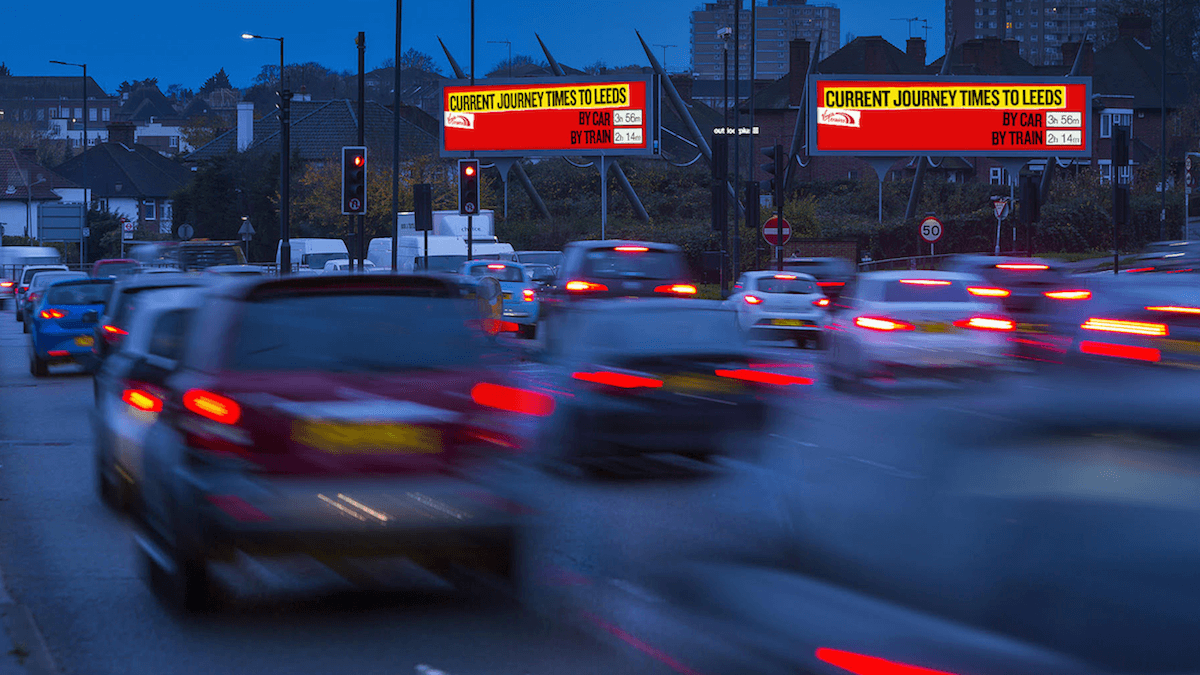Digital billboard ads for Virgin Train display live travel times in the UK
The campaign creators say this is the first time traffic and location data have been shown together in an outdoor campaign.

Digital out-of-home (DOOH) advertising has taken another step toward becoming a fully online medium, following a UK-based campaign this month that shows live data of current travel times.
Launched the second week of September and continuing till October 1, the campaign for Virgin Train is designed to show that “taking the train is faster than driving.” On various digital video billboards in the London, Birmingham and Leeds metropolitan areas, car drivers see a real-time comparison of car and train times along popular routes to various destinations.
The travel times are automatically updated throughout the day, based on live data, and the campaign creators say this is the first time traffic and location data have been combined in an outdoor campaign.
When traffic on a given route gets heavy, the travel time comparisons are also shown on small digital video displays in gas stations, restaurants and shopping facilities at rest stops along the route, a break-out into additional screens during peak times that the campaign also cites as a first.
The campaign was created by ad agencies Manning Gottlieb OMD and Anomaly and produced by DOOH production and creative tech company Grand Visual. It is managed and distributed via DOOH ad tech firm QDOT’s OpenLoop network.
The train times come, of course, from Virgin Train, while the traffic information is licensed from third-party sources. Time, date and location data is part of OpenLoop.
Possibilities
Grand Visual Chief Creative Technology Officer Dan Dawson told me via email that “the possibilities are endless as to how [live] data can be used to inform creative” across this and other digital advertising. Outdoor displays for time and weather are not uncommon, of course, but live data comparisons offer additional value to consumers.
There are other travel use cases, like train-versus-plane or subway-versus-car times, reflecting changing conditions. Or there might be campaigns that show, in real time, one car route versus another.
Data feeds informing digital outdoor displays are not limited to travel times. In June, for instance, National Geographic and Outdoor Advertising Association of America launched digital billboards in New York City’s Times Square and elsewhere that accepted moderated posts from live Twitter and Instagram feeds, also employing QDOT’s OpenLoop platform.
A campaign last year for Dannon Yogurt triggered different images on the digital billboards, based on a live feed of traffic conditions. And a startup called Pecabu has presented different digital billboard ads, triggered by a real-time assessment of weather, area demographics, and even info about viewers of the billboard, the latter based on feedback from an anonymized rewards app in passersby’s smartphones.
All of which points to the end of the static billboard. Not only is the imagery changing because it’s video or a series of still images, but the digital displays are increasingly utilizing data feedback from the environment or elsewhere to make the info more relevant and eye-catching.
Don’t be surprised, then, to see digital billboards at some point that change their look based on whether new polls show a change in a political race, if the local sports teams are reporting their in-progress scores or if average real estate prices fluctuate in two nearby neighborhoods.
Contributing authors are invited to create content for MarTech and are chosen for their expertise and contribution to the search community. Our contributors work under the oversight of the editorial staff and contributions are checked for quality and relevance to our readers. MarTech is owned by Semrush. Contributor was not asked to make any direct or indirect mentions of Semrush. The opinions they express are their own.
Related stories
New on MarTech